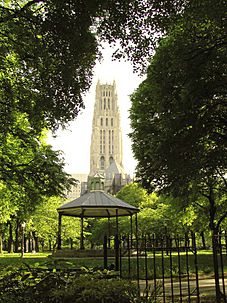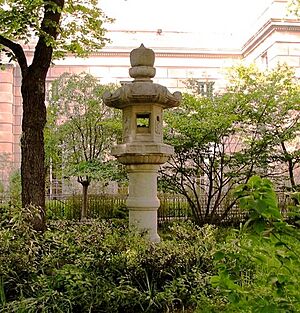Sakura Park facts for kids
Quick facts for kids Sakura Park |
|
|---|---|

Looking downtown, the gazebo in the foreground and the tower of Riverside Church behind it
|
|
| Type | Urban park |
| Location | Manhattan, New York City |
| Area | 2.067 acres (0.836 ha) |
| Operated by | NYC Parks |
| Status | Open all year |
| Public transit access | Subway: Bus: M4, M5, M11, M60 SBS, M104 |
Sakura Park is a beautiful public park in New York City. You can find it in the Morningside Heights area of Manhattan. It's located near West 122nd Street, between Riverside Drive and Claremont Avenue.
The park is surrounded by famous places. To the south is Riverside Church. The Manhattan School of Music is to the east. On the west, you'll find Grant's Tomb and Riverside Park. International House is to the north. The New York City Department of Parks and Recreation (NYC Parks) takes care of the park.
Contents
The Story of Sakura Park
How the Park Got Its Name

This park was first called Claremont Park. It got its name from Claremont Avenue, which runs along its eastern side. The land for the park was once owned by a famous person named John D. Rockefeller.
In 1896, New York City bought the land. They wanted to make it a bigger part of Riverside Park.
A Gift of Cherry Trees
A special gift changed the park's name. In 1909, a group of Japanese residents in New York gave 2,500 cherry blossom trees to the city. This gift was to celebrate the Hudson–Fulton Celebration.
However, there was a problem. The ship carrying the trees got lost at sea. Many of the trees started to rot. Only about 700 trees made it to Claremont Park.
Three years later, in 1912, the surviving trees were planted. They went into Riverside Park, Central Park, and the area around what is now Sakura Park. Because of these beautiful trees, the park was later renamed Sakura Park. "Sakura" is the Japanese word for cherry blossom.
Park Renovations and New Gifts
In 1932, Sakura Park got a big makeover. John D. Rockefeller Jr. gave $350,000 to help with the landscaping. This was part of the building of the nearby Riverside Church. The park's new look was finished two years later.
Another special gift arrived in 1960. The City of Tokyo gave New York City a tōrō. A tōrō is a traditional Japanese stone lantern. This gift celebrated New York City and Tokyo becoming "sister cities."
Crown Prince Akihito, who later became the Emperor of Japan, was there for the dedication. He officially presented the tōrō on October 10, 1960. He returned in 1987 with his princess, Empress Michiko, to rededicate the lantern.
What You Can See in the Park
The Daniel Butterfield Statue
In Sakura Park, you'll see a large bronze statue of General Daniel Butterfield. He was a famous general from the American Civil War. He also wrote the bugle call called "Taps." This tune is often played at military funerals.
The statue was made by a sculptor named Gutzon Borglum. He also created Mount Rushmore! The statue faces Grant's Tomb across Riverside Drive. It looks like General Butterfield is gazing at the tomb of his fellow general and former president.
Park Design and Cherry Blossoms
The park has two main paths lined with tall linden trees. Their branches meet above, forming a leafy tunnel. Between these paths is a grassy lawn. You'll also find a gazebo and many cherry trees there.
When the cherry trees bloom in spring, the park is filled with beautiful pink and white flowers. Many people, especially those of Japanese heritage, come to celebrate Hanami. This is a Japanese tradition of enjoying the beauty of flowers, often with picnics under the trees. Before the cherry blossoms, other spring flowers like snowdrops and tulips bloom.
The Historic Wall
To the east of the park is Claremont Avenue. This street is much lower than the park. A strong, supported wall runs along the park's edge on Claremont Avenue. This wall looks like an old abbey wall from Kenilworth, England.
The Olmsted Brothers firm built this wall in the 1930s. It was part of the park's redesign at that time. The wall is covered in ivy, making it look even older and more beautiful.

